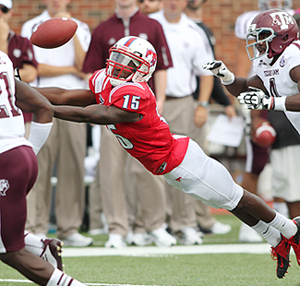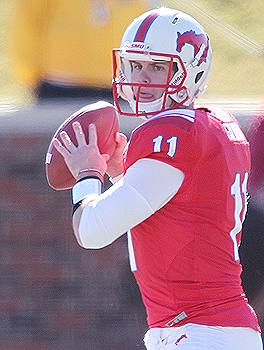Catching Up with Jason Phillips — Part I
Receivers coach breaks down his first season with SMU receivers
Posted on 06/23/2013 by PonyFans.com
For some, the 2012 SMU football season was one of great accomplishment, as the Mustangs set a school record by reaching a bowl game for the fourth consecutive season. For others, the season was a big “what if?” as unexpected losses to Tulane and Rice left PonyFans wondering in which bowl their team could have played had the Mustangs finished the regular season with two more victories.
 |
| Jeremy Johnson, who will be a senior this year, led the Mustangs with 67 receptions in 2012 (photo by SMU athletics). |
|
For the SMU receivers, last season was a roller-coaster ride, and not the thrill-a-minute kind that can be enjoyed at amusement parks. There were some great catches — see Darius Johnson’s twisting touchdown reception in SMU’s rout of Fresno State in the Sheraton Hawaii Bowl, Darius Joseph hanging on to a touchdown catch while getting drilled in the end zone against Tulane — but there also were some maddening drops of catchable passes, perhaps most evident in the Mustangs' game against TCU, a contest in which several passes from SMU quarterback Garrett Gilbert fell harmlessly to the turf.
There were legitimate reasons that affected the Mustangs’ passing game that night. The game was played in conditions that, at best, could be called “sloppy.” Gilbert was playing in just his fourth game with his new teammates after transferring to the Hilltop from the University of Texas. TCU brought a stingy defense to Dallas to face its cross-town rivals at Gerald J. Ford Stadium.
The performance also was just one game, and there was marked improvement as the season wore on, but as a group, the receivers battled inconsistency at times during the 2012 season. In SMU’s victory over UTEP the week after the TCU game, starting receivers Jeremy Johnson (8), Darius Johnson (5), Keenan Holman (5) and Der’Rikk Thompson (2) caught 20 of Gilbert’s 22 completions. In the Mustangs’ 72-42 rout of Houston, the quartet caught 20 of Gilbert’s 23 complete passes. They caught 20 of 25 in the win over Memphis. Against Southern Miss, the Johnsons, Thompson and Austin Fuller made all 27 of the Mustangs’ receptions.
The talent is there. Refining that talent was a priority as the season played out, and remains a priority throughout the offseason. SMU receivers coach Jason Phillips said part of the receivers’ early-season inconsistency could be traced to the fact that the Mustangs’ wideouts still were getting used to Gilbert, but also to the fact that he initially evaluated the players based solely on their talent, but with insufficient regard to their experience playing for him.
“I kind of evaluated myself (over the offseason) more than the guys,” Phillips said. “I came from the University of Houston, where I had the luxury of having (quarterback) Case Keenum there for six years. So when we got receivers who played as freshmen, they had the benefit of playing with a quarterback who had run the system before, who knew what he was doing and was comfortable running that offense. Sometimes it’s easy to take guys like that for granted. I came here last year with the same expectations for these guys that I had for those guys when they were seniors, when they had been working with Case for their entire careers, and that wasn’t really fair to them.
“The reality is that they were starting over last year — not starting over learning how to play football, but starting over with me as their coach, with Garrett as their quarterback. You can have talented players, but it takes time to get used to players. They worked hard in the offseason with each other, and they practiced hard, but until you do it in games, it’s not going to click right away. In the middle of the season, they started doing that. I think they did an excellent job in the latter part of the season, and by the time we got to the bowl game, they were really coming on. You could see the hard work they put in paying off. That carried over to this spring, and I expect it to continue to carry over into next season.”
Learning to play for Phillips didn’t mean the players had to re-learn how to play the game, or how to run a route or catch a football. But different coaches at all positions have different ways of doing things. So as the SMU receivers got used to their new position coach, it almost was as if they were freshmen again. They understood what he wanted, but adjusting to his teachings and making what he taught a natural part of their game took time, and is a process that continues heading into the 2013 season.
 |
| Receivers coach Jason Phillips said part of the reason some of the receivers battled inconsistency at times in 2012 was the fact that the season was their first working with transfer quarterback Garrett Gilbert (photo by SMU athletics). |
|
“I wouldn’t say they were not getting it — that’s not it at all,” Phillips said. “But every coach has a way that he likes things to be done, and I’m no different. I have ways I like things to be done, so it was just a matter of them getting used to it, getting used to me … and me getting used to them, too. So while they were learning the way I like things to be done, they’re also expected to pay very close attention to detail, and studying the defense we play each week. There are some talented players here, but that’s a lot. Now that they have a year of working with me, what I want will more second-nature to them. They can focus on little things and study the defense better, but they don’t have to think as much about certain things that we expect to come naturally to them. They have a better understanding of their role, a better understanding of the work that goes into being successful.”
Phillips also acknowledged that part of the receivers’ inconsistency related to Gilbert, the former national high school player of the year whose transfer to SMU was met with through-the-roof expectations of a program-changing savior. The expectations surrounding Gilbert grew from his record-setting high school career and the fact that he played at a marquee program in Austin, but Phillips pointed out that while Gilbert brought ample talent and athleticism and experience to Dallas, he still needed to work with his new passing targets to iron out some kinks.
“I think you definitely have to attribute some of those dropped balls to the guys adjusting to Garrett Gilbert,” Phillips said. “They worked hard over the summer with him, but it takes time to get used to a new quarterback. At Houston, the receivers and (quarterback) Case Keenum played together for three or four years. They knew exactly what each other wanted to do on every play. They knew each other’s body language. They knew how to react when they saw Case move one way or another, and he knew how to alter his throws based on their body language. That’s the kind of thing you can only do with time together — time spent playing games together — and that’s part of why our passing game got better in the second half of the season last year. They were starting to get comfortable with each other. The quarterback learns to adjust to his receivers, and the receivers learn to adjust to their quarterback.”
Since June Jones took over in 2008 as SMU’s head coach, the Mustangs have had a fairly clear “lead” receiver each season, a role filled by the likes of Emmanuel Sanders, Aldrick Robinson and Cole Beasley — each of whom now makes a living catching passes in the NFL. In 2012, the leader of the SMU receiving corps was a matter of opinion; many viewed Darius Johnson as the team’s top target, although Jeremy Johnson ended up leading the team in receptions with 67 (Darius Johnson was a close second, with 64 catches). Phillips said he doesn’t know that the Ponies need a lead receiver. On the contrary, he would rather receive contributions from several, rather than relying too heavily on one guy to carry the majority of the receiving load.
“I really strive for a more balanced approach,” Phillips said. “There are going to be games where one guy is going to be ‘hotter’ than the others, but at the end of the day, we want a group of receivers who can be ‘the guy’ on any given day. We’re not going to be a one-dimensional offense, where if you see the quarterback drop back, you know who he’s looking for. The more (receivers) who develop, the more multi-dimensional we can be on offense.”
(Coming in Part II: who stood out in spring workouts, expectations for incoming freshmen.)









